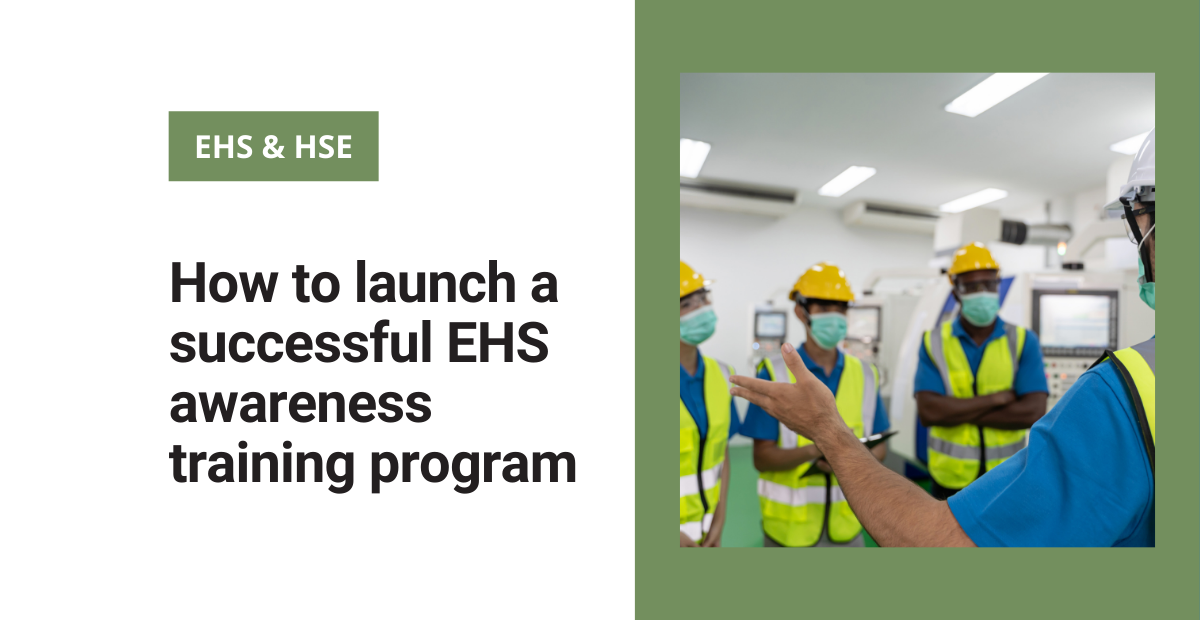Training is an important tool for informing workers about workplace potential hazards and controls so they can work safely and be more productive. Knowledge and awareness ensure that everyone plays a key role in developing, implementing, and improving the program.
Foundational components of an effective EHS awareness training program
Make sure you provide training to all workers at your facility, including contractors, subcontractors, and temporary workers. The program begins with training on:
- EHS policies, goals, and procedures of the facility
- Functions of the EHS program
- Whom to contact with questions or concerns about the program (including contact information)
- Procedures for reporting hazards, injuries, illnesses, and near misses
- What to do in an emergency: release, spill, fire, terrorist threats, etc.
- Your employer’s responsibilities under the program
- Workers’ rights under the Occupational Safety and Health Act (OSH Act)
You must provide workers with information on all known environmental, safety, and health hazards of the workplace and the controls for those hazards. Your employees need to be involved in identifying potential hazards throughout the facility. After all, they have a hands-on understanding of the workplace, which is invaluable in finding potential hazards.
Frontline learning management system
Frontline LMS is a powerful tool for administering and tracking EHS training.
Involving your workers in the entire EHS program development process ensures a quality training program and will help workers take ownership of their responsibilities. Make sure the workers understand the training. That means providing the training in the language(s) and at literacy levels that each worker can understand.
Include as part of your training, that all workers have the right to report incidents, hazards, and EHS concerns and to fully participate in the program without fear of reprisal.
Identify roles in the program
Everyone in your workplace is responsible for working towards EHS excellence. It’s a good idea to provide designated workers with specific training that will allow them to assume a leadership role in EHS programs.
Train on procedures for responding to emergency releases and spills, workers’ reports of injuries, illnesses, and incidents, including ways to avoid discouraging the reporting of incidents. Reporting an incident helps find the cause and prevent future incidents.
Additionally, instruct your workers on the fundamental concepts and techniques for recognizing hazards and methods of controlling them. This should include the hierarchy of controls:
- Elimination
- Substitution
- Engineering controls
- Administrative controls
- Personal protective equipment (PPE)
I’d also recommend teaching your workers incident investigation techniques like root cause analysis. This will help them understand how the EHS team investigates and addresses safety issues.
Specific roles training
Instruct workers assigned specific roles within the EHS program on how they should carry out those responsibilities, including:
- Hazard recognition and controls
- Participation in incident investigations
- Program evaluation and improvement
You should also provide opportunities for workers to ask questions and provide feedback during and after the training. As the program evolves, institute a more formal process for determining the training needs of workers responsible.
Hazard identification and controls
It’s important for workers to understand hazard recognition and control. Here are some of things you should teach them:
- Conducting a job hazard analysis
- Recognizing safety hazards
- Controlling hazards
- Using safe work practices and administrative controls
- Wearing and inspecting required PPE
Of course, provide additional training when you implement changes to equipment, processes, materials, or personnel.
Program evaluation and improvement
Your EHS awareness training program doesn’t end with establishing it and training workers. Regularly evaluating the program is necessary to ensure its effectiveness.
Program evaluation and improvement includes establishing, reporting, and tracking goals to see if the training program is working. Do all workers understand their safe work practices?
It also consists of providing ways for your workers to participate in evaluating and improving training.
Monitor progress
The first step in monitoring is to define indicators that will help track performance and progress.
Both lagging and leading indicators should be used. Lagging indicators generally track workplace and worker exposures, as well as injuries that have already occurred. Leading indicators track how well various aspects of the program have been implemented—how effective is the training in reducing release and spill incidents and injuries and illnesses.
Track lagging indicators, such as:
- Number and severity of injuries and illnesses
- Workers’ compensation data
- Number of spills or releases
Track leading indicators, such as:
- Level of worker participation in the training program activities
- Number of employee safety or training suggestions
- Number of hazardous spills, near misses, and first aid incidents reported
- Amount of time to respond to reports
- Number of workers who have completed the required training
- Worker opinions about the effectiveness of the program
After analyzing the performance indicators and evaluating progress, share your results with the workers and invite their input on how to further improve the program.
Correct shortcomings and identify opportunities
Whenever a problem is identified in any part of the EHS training awareness program you—in coordination with all workers—should take prompt action to correct the problem and prevent its recurrence.
Determine whether your performance indicators and goals are still relevant and, if not, how you could change them to drive improvements more effectively.
These program evaluation and improvement steps are effective for evaluating the success of any of your existing EHS programs, from your stormwater management to your hazard communication program.




